Few have thought about it, but in the country you can live comfortably all summer long and not run out of need at night into the cold street. wooden toilet or in an uncomfortable zinc bucket on the veranda. A warm toilet has become quite affordable even in a small country house. Moreover, its species are now given to summer residents and owners country houses offered by modern civilization set.
Sewer system in the country
One of the best options, which is laborious, but will serve the owners country house for many years - a full-fledged sewerage system in the country. This method of installing a warm toilet on dacha is suitable for those who spend a lot of time in the country, almost live on it for the entire summer season.Represents the installation of a toilet room in the house, even the smallest one in 1-2 square meters, output through the walls of the house sewer runoff to the street, where sewage waste falls into a sewer pit (septic tank) or into a plastic container. The method is not only laborious, but also costly. If you are not in the country so often, then you should look at other possibilities to install a warm toilet in the house.
In order to be able to fully connect the toilet to water, and not constantly pour it from a bucket into a tank, it is necessary that pure water was brought into the house. Provide factory cold water various plumbing devices will help in the house.
For example, the schema might look like this. Water enters the house from a well or a well in the yard. A special pump with an electric relay is placed in the water source, which is triggered when the water in the storage tank in the house falls below a certain level.
The pump, if necessary, silently pumps water into the storage tank located in the house. The pump is connected to the tank through a plastic pipe brought into the house.
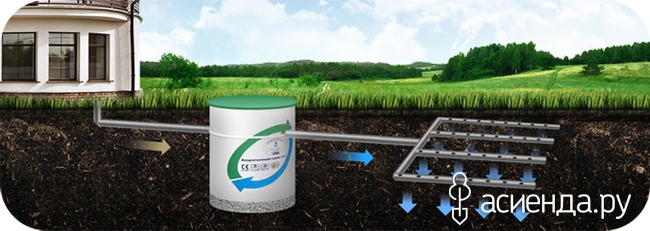
From the tank through the house there is a branch plastic pipes to the points where they are needed - for example, to the kitchen, to the washstand and to the toilet. As soon as the flushing of the toilet bowl with sewage is used, the relay on the pump in the well will work, and the water will again be drawn into storage tank. Almost like in the city!
sanitary bucket
The easiest method is a sanitary bucket with a special lid. It is installed on the veranda of the cottage or in another small room where people don't sleep or eat. The method is good for its low cost, ease of installation. But it is very primitive and inconvenient in terms of the fact that the bucket will have to be constantly taken out and the contents poured out of it into country toilet or dispose of it in some other way. In addition, the bucket will have to be washed daily so that there is no smell from it in the house.dry closet
Very convenient installation. A certain, fenced-off place in the house is allocated for it. This is where the dry closet is installed. By appearance It's just a small toilet. In his device there is a container for draining water, which must be added there, as well as a container for receiving sewage. Special chemical ingredients are added to this very container, which decompose sewage into odorless biomass. When filling such a container, the mass from it must be disposed of. One important point- it is better not to throw paper into such a bio-toilet bowl, but to put a bucket next to it for throwing away used toilet paper.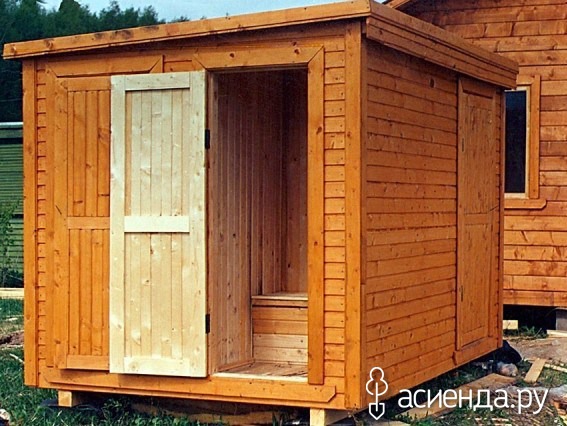
Toilet on turf
A special device, which is also a toilet bowl with two containers under the seat. The top container is filled with peat. The contents of our organisms enter the lower through peat.The toilet is considered the safest, most environmentally friendly option for a warm toilet. However, when installing such a device in a summer cottage, it should be done in it air vent so that unpleasant odors go outside the building.
![]()
New - electric toilets
This is one of the newest developments of scientists who stand up for the environmental friendliness, convenience and warmth of our sanitary rooms outside the city.It is a device that separates waste when sewage enters it into liquid and solid. The liquid will then have to be discharged into the sewer, and the solid waste is pressed and placed in a container with bricks. Other models of electric toilets even burn such “presses” inside themselves.
Among the shortcomings are special installation conditions, the presence of sewerage, hoods in toilet room, access to permanent electricity and the cost of it, and the high cost of equipment.
One of the requirements for working on suburban area is the availability of basic amenities. Only in this case it will be comfortable to do the work. A bathroom can be built not indoors, but on the street. In this case, you should think about how to build a warm toilet in the country with your own hands. It will be possible to stay in it not only in warm summer days but also in windy winter. What materials will be required for this and what projects are there for implementation? This is what will be discussed in the article.
What are the toilets in the country
Country toilets can be divided into two large groups:
- With cesspool;
- without a pit.
Each type of toilet has its pros and cons, in some cases there will be no other way out than installing a device without a cesspool. This may be due to the location of the site, as well as the proximity ground water.
Without cesspool

One type of toilet that is not equipped with a pit for collecting sewage is a powder closet. Its name alludes to the fact that it does not use water for flushing. The absence of a pit does not mean that there is no waste collection tank at all in the toilet. It is located directly under the seat. Every time after visiting the restroom, the waste falls asleep organic matter, for example, peat. After processing, the output is a natural fertilizer that can be used in the garden. Most often, the design of such a toilet consists of two containers. One of them is smaller and fits in a larger container.
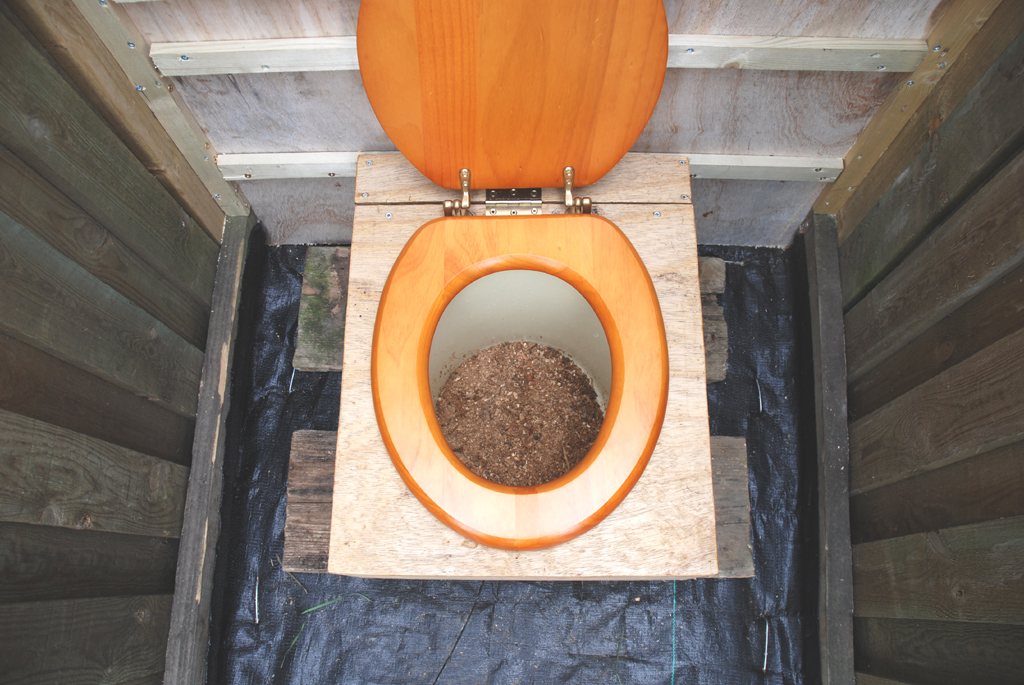
The smaller one is for collecting solid waste. Holes are made along the perimeter of its walls through which the liquid will go into a large container. From the latter, a natural drain is made from the toilet into the ground through a hose. After filling the tank, it is taken out to compost heap, where it can acquire the required characteristics along with other waste. On sale there are ready-made designs of such latrines. If there is a desire to assemble the toilet yourself, then it is necessary to consider a mechanism for extracting a smaller container. This can be done directly in the toilet cubicle or a separate door can be provided, for example, at the back of the structure.
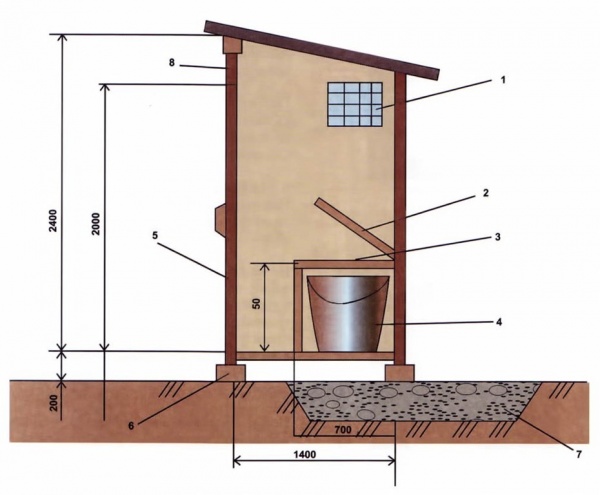
With cesspool
Pit latrines are the most common and easiest to make latrines. They imply the presence of a recess in the ground. The dimensions of the pit under the toilet may vary depending on the needs. So that the walls do not sprinkle, they are reinforced with bricks, poured with concrete, or simply placed inside a large plastic barrel. In some cases, they choose to lay inside the old tires from the car. If such a restroom is used only in the season, then some prefer not to bother with strengthening the walls.
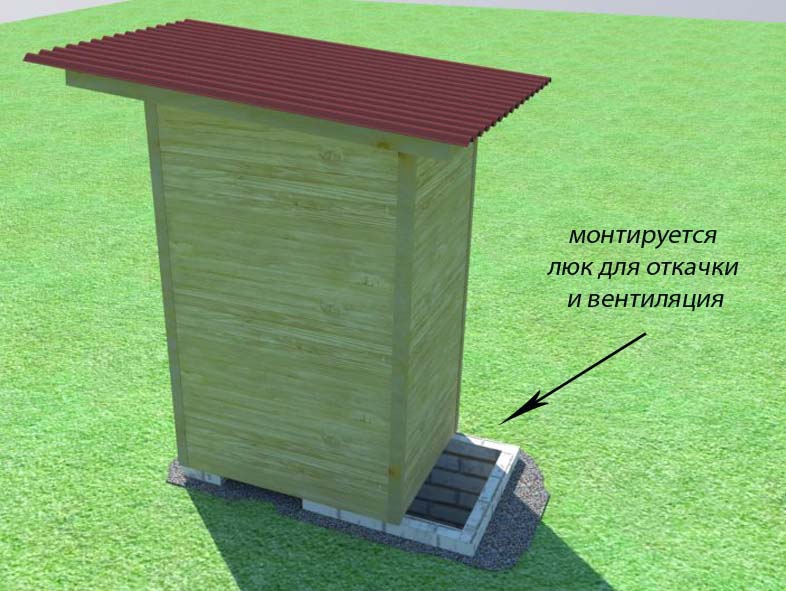
A small house is being built above the recess. The toilet can be made from various materials. Most often, a wooden structure is chosen from improvised means. Filling the pit takes certain time, so cleaning it will not be expensive and may be needed in a few years. Everything will depend on the intensity of use of the toilet. A pit toilet is considered not the most best solution because of the smell it contains. But this issue can be solved with the help of ventilation pipes in the restroom.
The pipe rises to a level that exceeds the highest point of the roof by 50 cm. A deflector must be installed at the end, which will ensure air rarefaction and traction. Fence clean air carried out directly through the opening in the toilet room. It is important to be careful that there are no additional supply openings, as the system may lose its effectiveness.
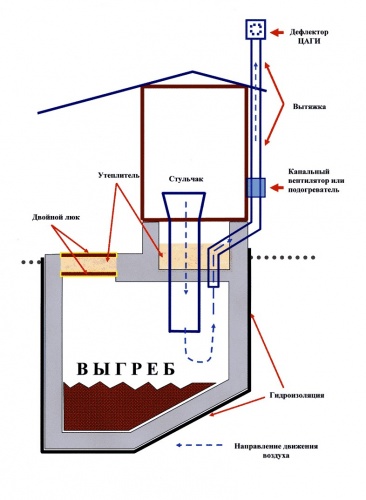
Some owners provide forced ventilation in the latrines. It works on blowing, throwing air from the room to the outside. To do this, a fan is inserted into the window or other hole in the wall of the toilet, which performs the operation. It can be turned on a few minutes before going to the toilet or set to automatically turn on when the toilet door is closed. For such a system, there must be a source of inflow so that a low pressure zone does not arise inside the toilet.
Advice! Installation forced ventilation in the toilet does not eliminate the need for ventilation directly for the cesspool under the toilet.
dry closet
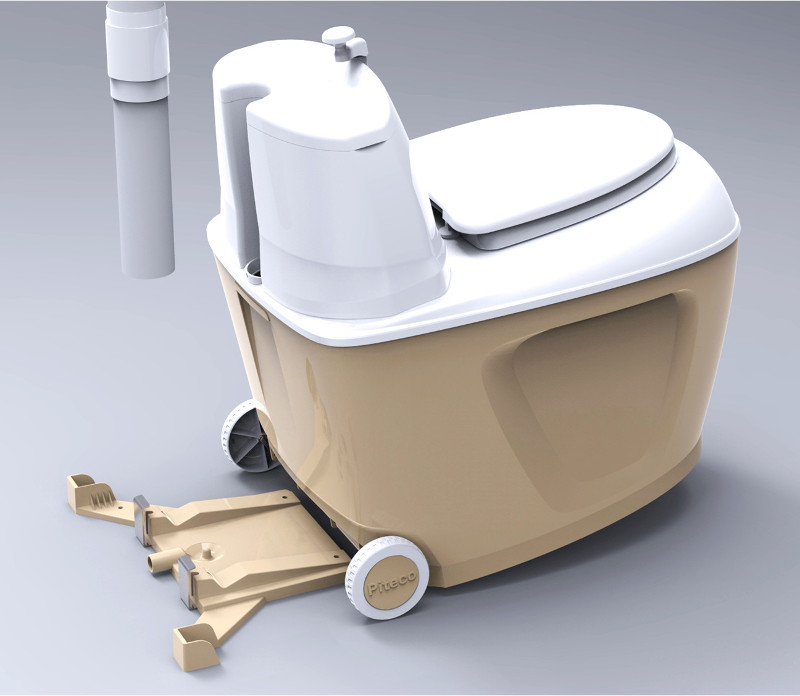
A dry closet is one of the varieties of toilets without cesspools. There is no need to build them, you need to plan in your budget the amount for its purchase. At the same time, there are several various options latrines. One of them is sold immediately with a finished booth. It is made of plastic and will last a long time. Another type of dry closet is a small container with a toilet seat. It needs to build small room. The essence of the functioning of such a toilet is that active bacteria process waste, decomposing them into silt and water. For a dry closet, a water drainage system can be provided. Dry deposits are used as fertilizer for fruit trees.
Combined variant
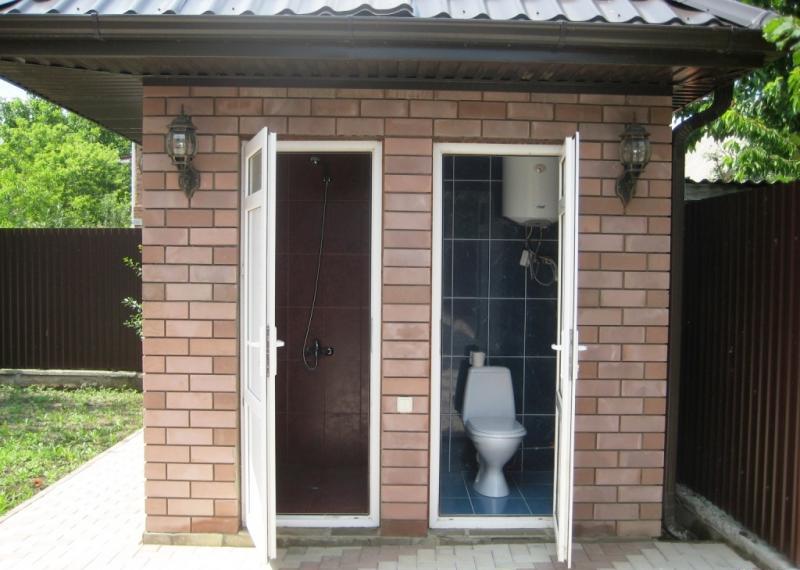
The combined version of the toilet can be a building with several entrances. They can be made to differentiate visitors by gender. They usually have one cesspool if they are of this type. In the next booth can also be built Summer shower. The drain from it is directed to a cesspool or to an open space with a filter base if it is visited infrequently. The toilet can be adjacent to a small closet where it will be stored garden tools.
Project
The main task before the design of the building for outdoor toilet consists in choosing a place for its installation. This is especially important if the restroom is made with a cesspool. The toilet must be at least 5 meters from the house. It is desirable to make it larger so that unpleasant odors do not reach the dwelling. Special attention It is worth paying attention to wells or other tanks for storing water. It is important that waste does not leak into them in any case. To do this, it is necessary to provide for a distance of at least 30 meters. If there is nearby fruit trees, then they also need to maintain a gap of 5 meters. It will be convenient to locate the toilet closer to the road, from where the access of the sewer will be carried out, but a distance of 5 meters must also be observed to it. From neighbor's fence it is necessary to remove the toilet by 2 meters or more.
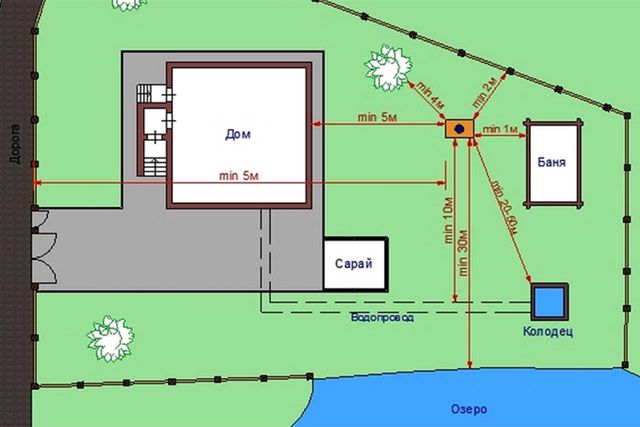
After choosing a place for the restroom, you can determine the size of the future building. There are a few rules that apply to outdoor toilets. For example, the height of the restroom should not be too high. If it exceeds 2.5 meters, then due to the high windage, the toilet will simply be overturned. If the height of the roof of the latrine is below 2 meters, then there may not be enough air in it and there will be some difficulties for tall people to visit. In order to make it convenient to turn around, the width of the outdoor toilet should be from 1 meter. The depth of the restroom is also an important factor so as not to rest your knees on the door, so it is calculated from minimum value at 1.2 meters. Below is a drawing of a country toilet, on which all the required dimensions are indicated.
Note! For brick buildings of latrines, the maximum height of the room can exceed 2.5 meters without fear of damaging the structure.
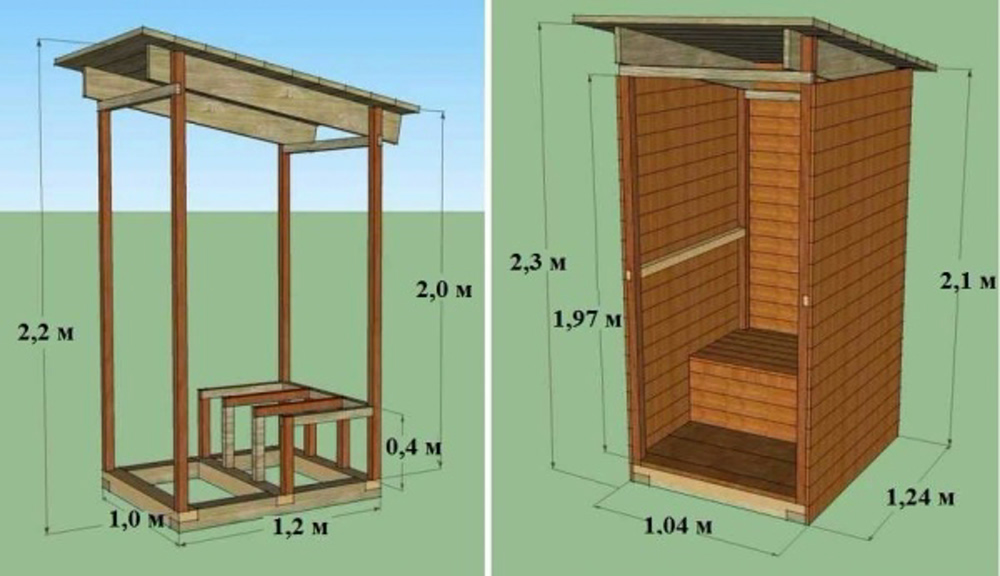
What to build from
After choosing a specific size of the restroom, you can decide on the material from which the construction will be carried out. His choice will also depend on the expected period of use of the country toilet.
Wood
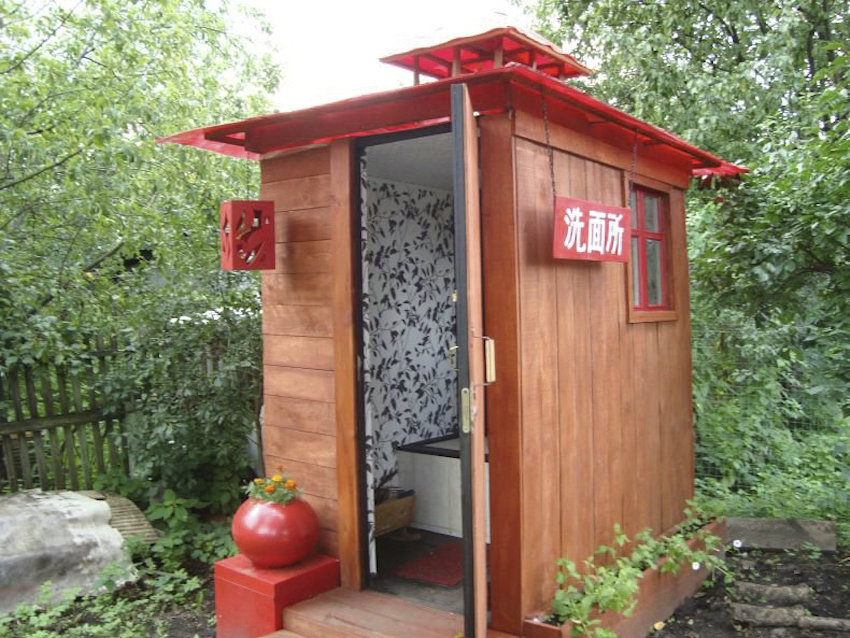
Wooden cubicles for toilets are the most common. This is due to the fact that latrines can be built from the remnants of the material that is stored after the construction of the house. The advantages of such a solution include:
- high speed of erection;
- ease of repair;
- ease of ventilation;
- the possibility of transferring the structure;
- light weight;
- the possibility of independent construction.
It takes about a day to build a wooden toilet box, taking into account the preparation of all the necessary details. The main frame in the design of the restroom is the main frame, which consists of a beam with a size of 10 by 10 cm. When the frame is ready, it is simply sheathed affordable boards. Renovating such a restroom is not difficult. It will be enough to replace the leaky part. As roof deck even a roofing material can be used for a restroom if it is placed at an angle on solid crate. Wooden structure the toilet turns out to be quite light, so several people can move it to a new place.
Metal
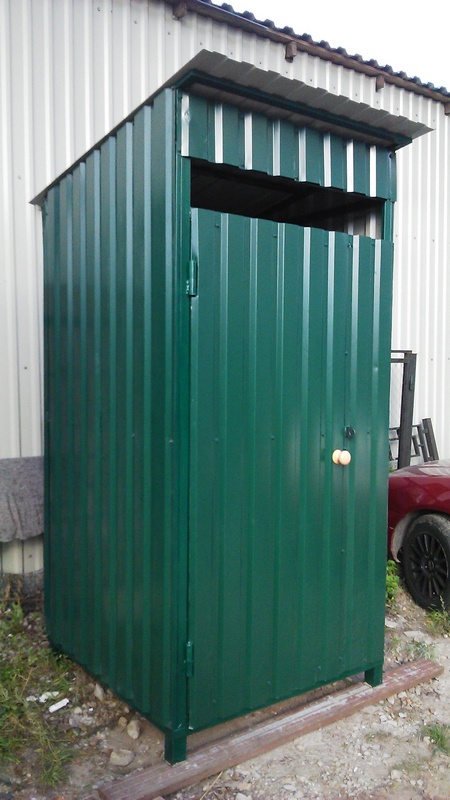
The construction of a metal toilet will require skills in working with welding machine. At the same time, it can be built much faster than wooden version restroom. The advantages of such a restroom will be:
- long service life;
- ease of maintenance;
- low price of the project;
- the possibility of movement;
A metal toilet is a base that is sewn up with one of roofing materials. Most often, corrugated board or slate is used for this. The first can be fixed with self-tapping screws or aluminum rivets.
Blocks
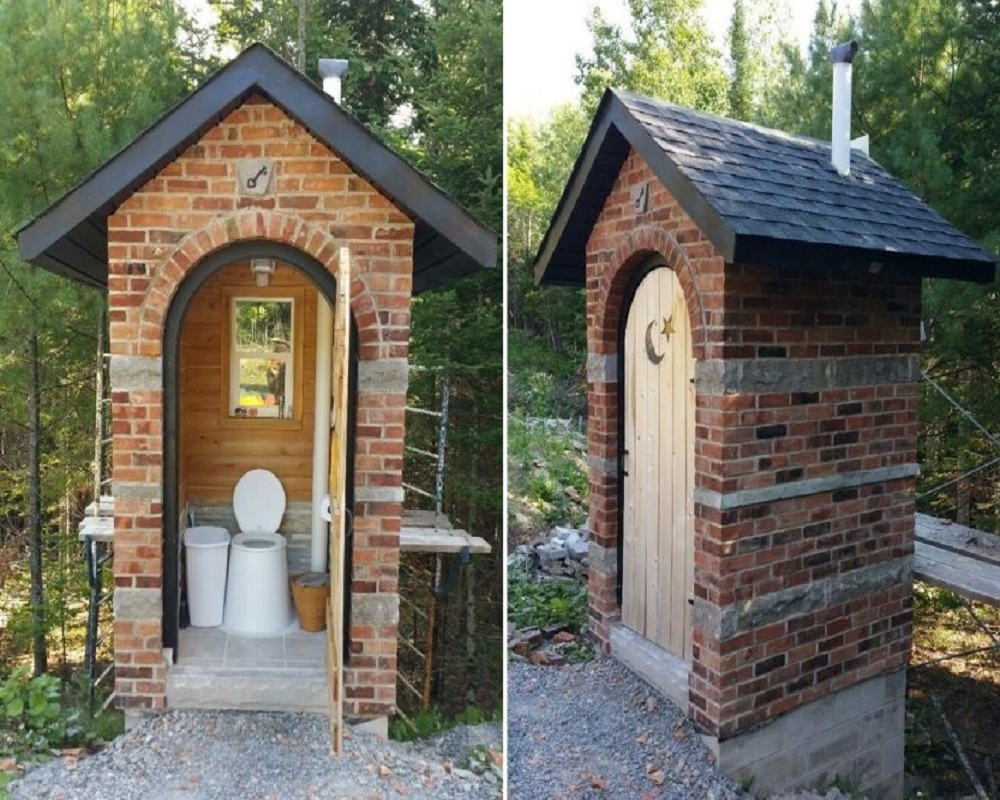
As blocks for building a toilet, you can use silicate brick, foam block, shell rock, etc. The advantages of just such a project can be considered:
- ease of insulation;
- coolness in the hot season;
- resistance to any kind of loads;
- presentable appearance;
- long service life;
- ease of form selection.
Even an inexperienced builder can lay a toilet. There will be an opportunity to practice on the restroom before the implementation big projects. It will be convenient for such a toilet in the country to make a cesspool under it, which will eliminate the need to constantly take out waste. Such a toilet will cost more than the above options for latrines. In addition, for such a restroom, it is necessary to take care of a high-quality foundation that can withstand the weight of the structure.
Examples of finished projects
One of the most simple solutions for country toilets, which are used everywhere, is the construction of a "birdhouse". This is the name of the standard restroom rectangular shape. Most often she has shed roof which is made from slate. Below you can see a drawing indicating the dimensions of just such a restroom. Among the shortcomings, it is worth noting the instability of the restroom to loads, as well as the need for additional upholstery which will get rid of drafts.
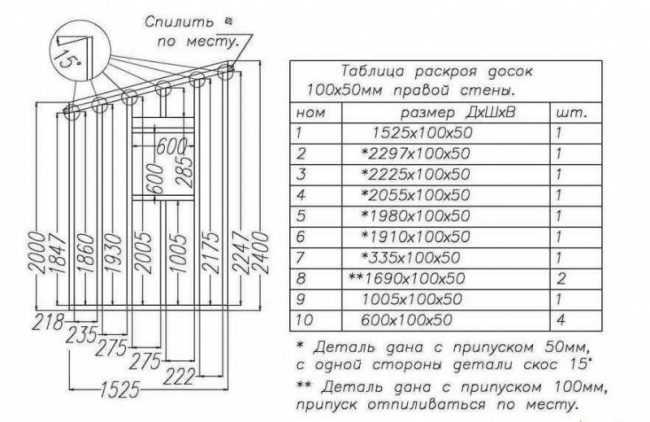
If you want something more intricate, then you can build a triangular toilet. They call it a hut. It is him that he resembles in his form. The triangle is one of the most stable shapes, so such a restroom can withstand both wind and snow loads. Unlike the previous option, the snow cover will not be able to accumulate on such a restroom. Below is a drawing showing all dimensions of the restroom. You should not save when choosing the width of the toilet. If it is made too small, then it will be almost impossible to stand up in the restroom.
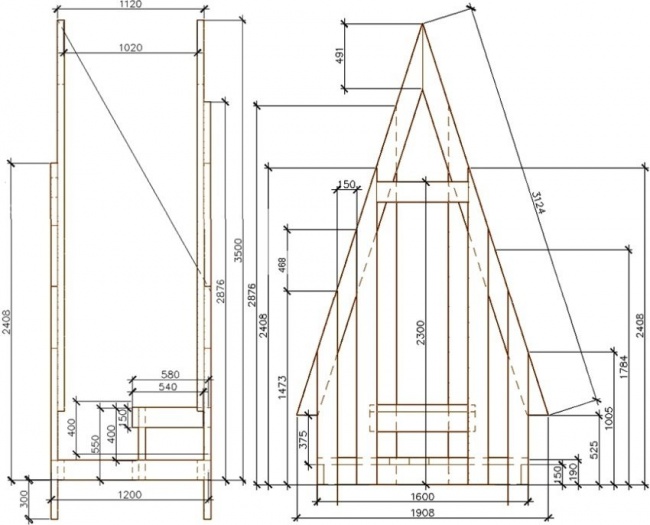
More difficult option toilet for making in the country is a lavatory in the shape of a diamond. It is also called a hut. Such a toilet will require a significant expense. building material. But in relation to such a restroom, you can be sure of stability even with strong winds. Another solution would be to build a latrine in the form small house. He usually has gable roof and is constructed from any kind of materials.
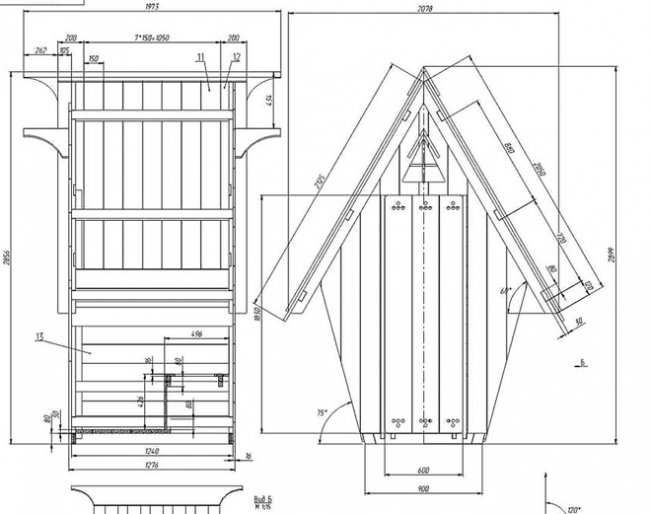
The procedure for constructing a warm toilet
The construction of a warm toilet in the country begins with laying the foundation. If the cesspool has already been dug and ennobled, then you can start making the foundation. There is no need to do it with a large depth, because. total weight the building will not be too big. A square and a rectangle are marked for the restroom. Pegs are hammered in the corners and a fishing line or rope is pulled between them. Using a tape measure, the size of the sides is checked, as well as the diagonals of the future restroom. This will straighten out the corners. You can also use the most common square. The width of the trench for the latrine, which is dug according to the marks, should be from 20 to 30 cm.
It is necessary to deepen at least 50 cm. The walls of the trench under the latrine are compacted. A layer of crushed stone 10 cm thick is poured to the bottom. Medium-grained sand is laid in the same layer. It must be well compacted so that the load is evenly distributed over it. The foundation of the restroom should rise 15-20 cm above the ground. Therefore, it will be necessary to build a small log formwork. It is displayed both vertically and horizontal level, which will facilitate the further construction of the restroom. The reinforcing mesh is laid in a trench and rises by 5 cm so that the mortar gets under it. The solution is poured and the upper end is leveled with a trowel.
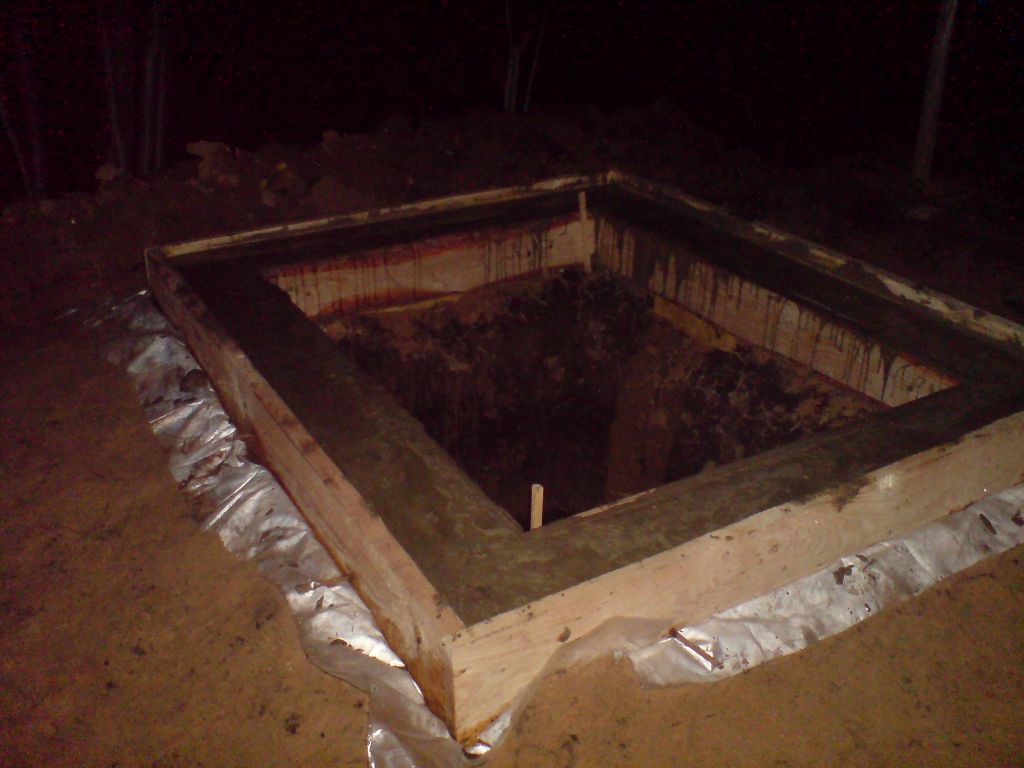
It will take from two weeks to a month to set the strength of the base for the restroom. Everything will depend on weather conditions. The next step is the floor for the restroom. It can be made wooden or monolithic. For the latter, you need to install wooden poles, lay waterproofing, mount a reinforcing mesh and fill the space concrete mortar. In this case, in the middle with an offset to back wall you need to leave a hole for the toilet. For this you can apply wooden frame. A small rectangle is knocked down, which fits into the place of the hole. Before erecting the walls of the restroom, it is necessary to provide waterproofing. Apply to the foundation bituminous mastic and a double layer of roofing material is laid. On it you can carry out bricklaying or installation of a wooden frame.
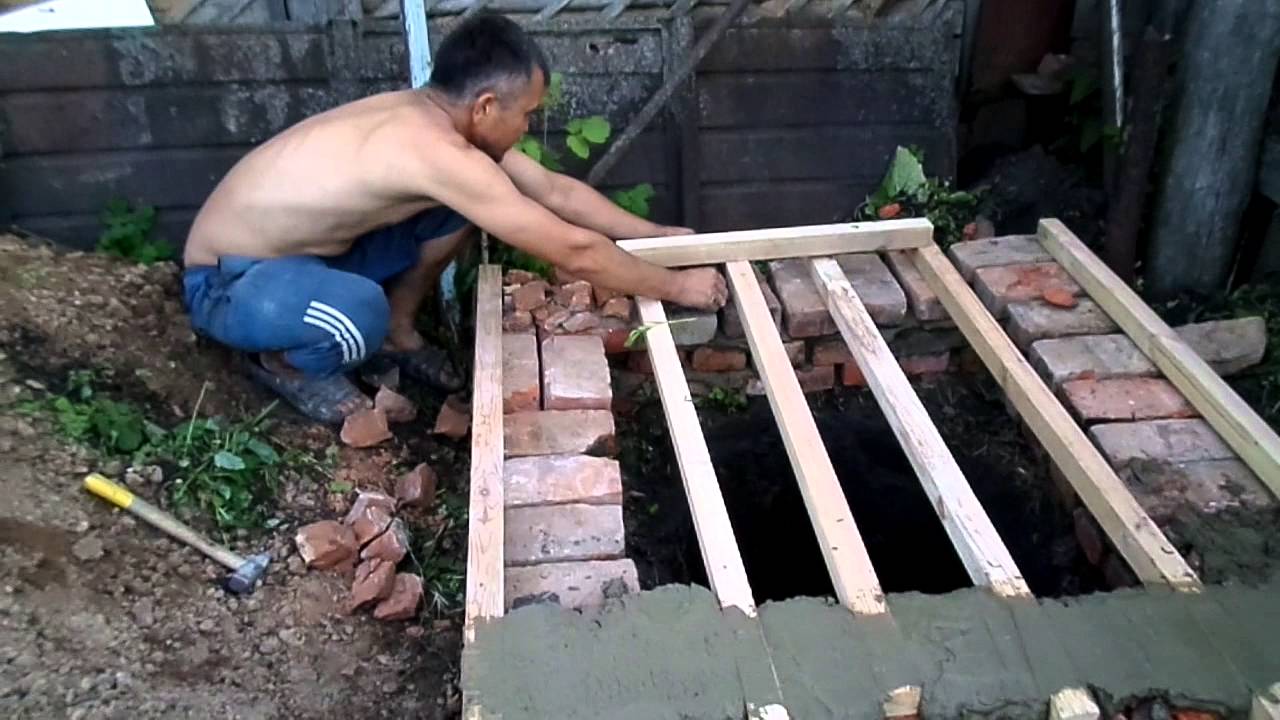
The last step will be the insulation of the walls of the restroom. For these purposes, penoplex will be an excellent material. It can be attached to brick wall with special umbrellas. After that, it is plastered with further finishing. The roof should also be insulated. For this, foam sheets are attached with inside and closed with a vapor barrier. After that, the ceiling of the toilet can be lined with clapboard or other material. Particular attention should be paid to the door. A warm toilet cannot be closed simply wooden shield. You will need to purchase a complete wooden door for the toilet. If the restroom is to be used in winter time, then inside you can put a small heat fan with the ability to turn on from home. This can be done in a few minutes for a visit, which is quite enough to raise the temperature to a satisfactory level.
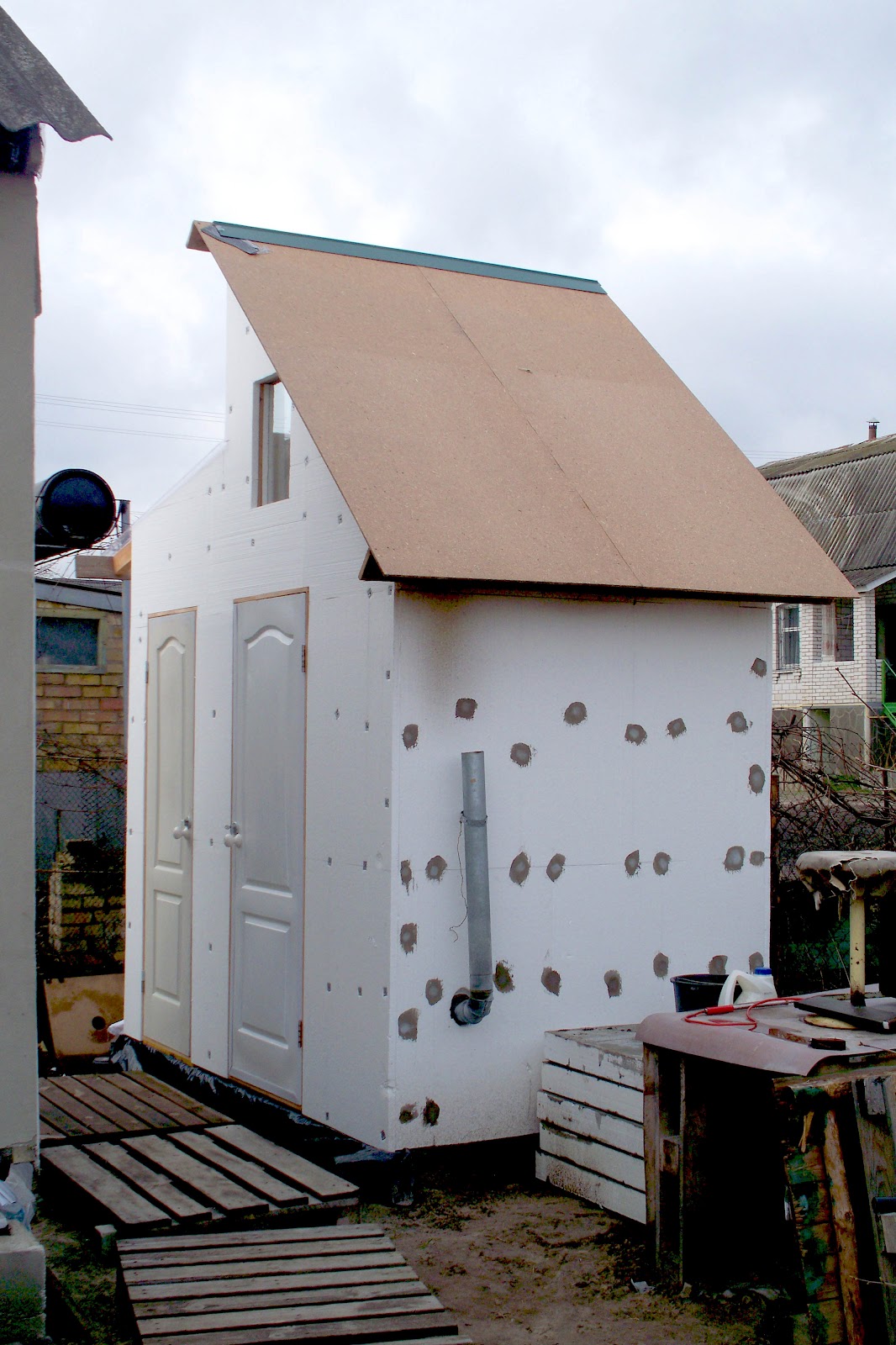
Note! You can build a warm toilet for a summer residence not only using brick or other stone. It is easy to make a toilet out of wood or metal, but then you will have to put more effort into warming the restroom. You will need to make sure that the cesspool does not have cracks through which weathering would occur. A video of the construction of such a toilet can be viewed below.
Conclusion
As you can see, it is easy to build a warm toilet using any of the above designs. Its use will be available at any time of the year. An outdoor toilet remains an indispensable solution for those areas where there is no centralized sewerage. For greater convenience, electricity for lighting can be connected to the restroom. Switches make it easy to turn it on. One of them can be located in the house, and the second directly in the toilet.
A real nightmare for many people who decide to move to a private house for a vacation or even for good, is. Indeed, in cold weather, especially in winter, when the temperature drops to -25 ... -35 degrees, and the wind throws snow in your face, it is extremely unpleasant to use a toilet located on the street. Therefore, warming the toilet is a completely logical decision - almost all people come to it sooner or later.
Insulated toilet
Of course, as with any other business related to repair or construction, it should be approached very seriously and carefully.
Why you need to insulate the toilet
If you want to be really comfortable in the country toilet, you need to provide it with high-quality thermal insulation, which, when correct installation will protect the toilet from drafts.
Being in the toilet, through the cracks of which the icy wind blows, is a truly extreme exercise. But most country toilets are built from boards, which are almost impossible to fit so tightly that the wind does not penetrate through the cracks.
The resulting draft not only quickly weathers the remnants of heat, but also makes you feel the frost more acutely. You should also not forget about thermal insulation. Someone may be surprised: why is it necessary to insulate a country toilet at all?
After all, thermal insulation is needed only in cases where there is a need to retain heat without releasing it outside.

Where can heat come from in an unheated toilet? Being in the toilet for a few minutes, a person simply cannot raise the temperature with his presence and breathing. That is why, in most cases, thermal insulation is a secondary task when warming the toilet.
However, this is not always relevant. If you want to install a peat toilet in your country house, then the issue of thermal insulation becomes more relevant. Alas, very few people know about this kind of toilets. Therefore, it will be very useful to talk about them in more detail.
What is a peat toilet
The peat outdoor toilet is considered by many experts to be a new stage in the development of autonomous plumbing. It is a rather bulky toilet bowl (volume of 100 liters or more), into which peat is poured (in some cases, sawdust).
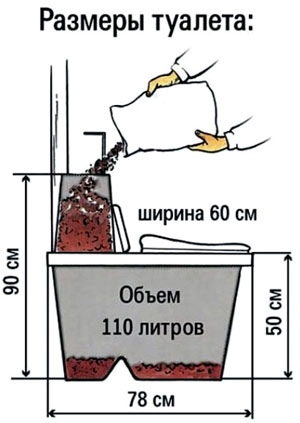
Human waste enters the toilet, where it is filtered and gradually decomposes.
Of course, the technology is far from new. For many decades there have been dry closets that use special chemicals to quickly decompose feces. However, chemicals have to be changed about once a month, while peat once covered can last up to 12 months.
The very fact that natural peat is used for cleaning, and not complex chemical compounds, will pleasantly surprise many people.
After 12 months, peat, like human waste, decomposes, resulting in several tens of liters of high-quality fertilizer that can be used to feed a wide variety of plants.
Experts are well aware that quite a lot of heat is released during the decomposition of organic residues. This is partly the basis of the principle of operation peat toilet. Liquid waste impregnates the peat, which quickly heats up and evaporates them. BUT good ventilation effectively removes the purified steam outside the toilet (all salts remain on the peat).
How to insulate a toilet
When insulating a toilet, the question arises: how to insulate it? Outside or inside? Most people prefer the first option. There are several reasons for this.
- Space saving. Of course, thermal insulation materials take up very little space in the room. But after all, the area of \u200b\u200bthe toilet is very small. Therefore, even a slight decrease in it immediately catches the eye, creating the illusion of inconvenience and discomfort.
- Reducing bad odor. Many thermal insulation materials have high porosity. And bad smell, which is typical for most toilets, quickly impregnates the material, which will make it very uncomfortable to be in the toilet, especially on hot summer days.
On the other hand, it is believed that it is much easier to insulate the toilet from the inside with your own hands. In this case, even a person who does not have experience in such work will be able to prepare a toilet for the winter.
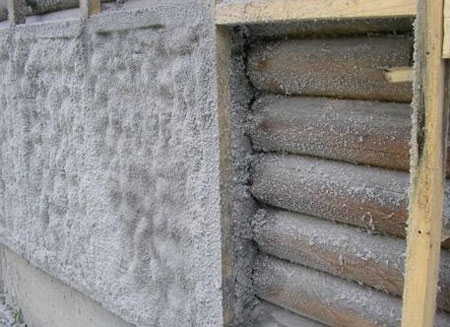
When you decide on the method of insulation, you can proceed to the next step - choosing the right insulation.
How to insulate a toilet
Toilet insulation can be carried out using the most different materials. For example, polyurethane foam is very popular. It is applied to the outer or outer wall with the help of special equipment, it hardens in a matter of seconds and provides excellent protection against heat loss, as well as drafts.
Most owners of country houses often face the problem of warming the toilet located on the site. Thus the question arises:How to insulate an outdoor toiletwith the use of improvised materials and at minimal cost?
Due to the limited space, as a rule, a heater is used, the width of which does not exceed 75 mm
In general, before choosing suitable option it is necessary to decide in advance which part of the building will be subject to insulation: internal or external. Based on this, the most suitable method of warming the outdoor toilet is selected.
When insulating the internal walls of the toilet, it is important to remember that in conditions of limited space it is best to use such a heater that will not take up much space and provide maximum structural stability from frost, cold and wind. Moreover, in favor internal insulation says also the fact that the funds spent on this are significantly less than those that would go to external insulation.
However, in each case, it is necessary to proceed from the material that went into the basis of the construction of the toilet. At external insulation material is used that fits over the walls of the toilet. In this case, you must choose suitable technology insulation. Thus, warming the toilet in the country will require significant financial investments but will provide the best results.
Features of the choice of insulation and materials for work
Due to limited space, usually The ideal option for this are the usual mineral plates. However, in addition to this, you will also need the following materials:
- Rectangular metal rails.
- Film(it will be needed for waterproofing).
- Drywall sheets(Moisture resistant is best).
- fasteners(self-tapping screws, profiles).
- Putty(Needed to cover the joints of the joints).
For selection the right amount materials must be based on the actual parameters of the toilet (width and height).
The process of doing work
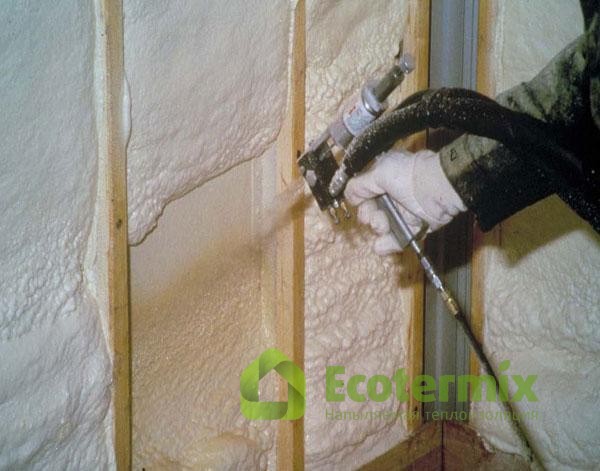
The sprayed polyurethane foam does not leave gaps and gaps, due to which best performance thermal insulation and wind protection
The first step is to carry out the crate with the help of wooden slats. They should be driven in at a distance of 50 cm from each other. Then a heater is laid on them, which is fastened with screws directly to the crate. After the plates are laid on the walls and ceiling, you can proceed to the film. It is used for waterproofing the premises, i.e. to prevent moisture from entering the surface of the insulation. Usually the film is attached to the plates with adhesive tape.
The final stage remains - landscaping. Drywall sheets can be used to hide the plates. They are attached with metal profiles using self-tapping screws. The joints of the joints are smeared with putty. After that, on the walls and ceiling can be laid decorative tiles or wallpaper. This completes the thermal insulation of the outdoor toilet. You can read about the insulation of the barn and outbuildings on the page.
As can be seen from the above, this process very, very laborious, requiring considerable costs, both time and finance ... But there is an alternative!
High-quality thermal insulation with polyurethane foam
Now, this material has become very widespread due to its versatility and excellent characteristics that distinguish it from others. thermal insulation materials. In general, polyurethane foam can be used as a heater, both for exterior and interior decoration.
The main advantages of PPU as a heater for outdoor toilets:
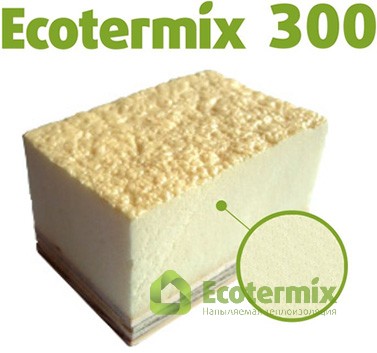
In addition, the insulation of a toilet located on the street with polyurethane foam is universal. This is due to the possibility of using PPU boards. They are hardened forms of polyurethane foam that are used to insulate a room. So, PPU boards are successful, which increases their heat capacity as a whole.
The main advantages of polyurethane foam boards can be considered the following:
- High wall adhesion. Regardless of what material the outdoor toilet is made of, the plates do not form cracks and gaps through which heat is lost.
- High resistance to physical activity and deformations. Due to its structure, polyurethane foam boards do not lose their shape throughout the entire service life.
- At correct styling, the material will not lose its thermal insulation characteristics for 70 years.
- Complete environmental safety.
- When moisture gets in, the insulation absorbs no more than 2% of its mass. The rest of the liquid will not touch the walls of the toilet.
Brief conclusions
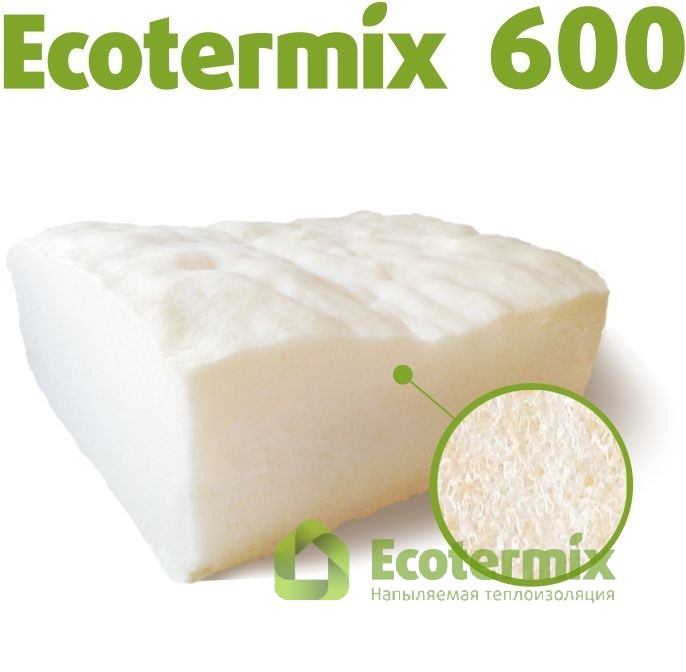
Ecothermix 600 - best material for internal insulation
In conclusion, it should be noted that the thermal insulation of an outdoor toilet is an important process and cannot be ignored. Agree, it is much more pleasant to cope with natural needs in a comfortable, insulated room without cracks and drafts. When choosing materials for thermal insulation of such a structure, it is necessary to proceed from the location of the toilet, its size and the desired result, which will result from the insulation. Well, it's down to personal preference, of course.
For example, to save free space, you can try using sawdust as a heater or basalt wool. Of course, they will not be able to significantly save inner space, and when used as a heater outside, they do not particularly differ in elevated thermal insulation characteristics, which are necessary for a country toilet.
Therefore, it is quite logical that today the best option insulation can be considered the use of polyurethane foam boards, when combined with the installation of which is sprayed with polyurethane foam (as a rule, internal walls), you can achieve the maximum effect of thermal insulation.
Video on how polyurethane foam is sprayed from Ecotermix:
The prices for the services of our company can be found in the section
Or order a consultation of a specialist at a convenient time for you!
Request absolutely free and does not oblige you to anything!
One person produces about 400 kg of liquid and 100 kg of solid “natural waste” per year. In the conditions of urban civilization, the question of where to put this “wealth” has been resolved.
But what to do with him in the country, where sewer pipes missing?
That is why in Russian villages, and even more so in dachas, wooden toilets with cesspools are still being built.
How to arrange, many country houses building themselves are thinking. Yes, and those who have them dream of changing the “houses of thought” for something more modern. Some even strive to arrange a toilet like in a city apartment with a toilet bowl. That's just the drain pipe has to be taken out to the concrete storage of feces, the so-called "rings", buried in the area. And all the same, a sewage truck, once a year or more often, must come and clean this storage.
Per recent times many new ways of arranging a country toilet have appeared. In any specialized store, a sales assistant will tell you in detail how the toilets are arranged in the country, and will offer a dozen alternative options wooden "birdhouse" with a cesspool. At the same time, the variety of country toilets can be reduced to two main types - a dry closet and a dry powder closet. Each of them has its own advantages and disadvantages.
Inexpensive models of dry closets cannot boast of special environmental friendliness. The waste in it is deodorized and dissolved in a special tank, turning into a liquid, which it is desirable to drain into the sewer. And where can I find her in the country? A family of 4-6 people will need to empty the dry closet every 2-3 days, and its contents do not smell the best.
Powder-closet is an ordinary toilet seat with a removable bucket-capacity. It is also sometimes called an ecological country toilet. The “result” of a toilet entry in a powder closet should be sprinkled with sawdust, ash or peat with a scoop. The contents in composting models are accumulated in a special tank where fertilizer is prepared for the garden.
It turns out that these “” cannot completely replace the old, proven “birdhouse” with a cesspool - you ask.
Fortunately, modern chemical science has yet invented a substance that deodorizes the contents of cesspools and facilitates their decomposition. Special biogranules turn the fecal matter into a cloudy liquid, while reducing its volume. This liquid has almost no smell and can be used to water the garden.
In conclusion, it should be mentioned that human "deposits" after their processing into compost are of much lower value than their animal counterparts.
How to make a warm toilet in the country
Our dachas have almost everything, like in Greece, cozy house, an orchard with apple trees, a greenhouse, even a source of water in the form of a well or a well. But often in the house there is no main among household amenities - a warm toilet. After all, the booth standing in the far corner of the site is simply ridiculous to take for a toilet. Meanwhile, a real toilet with a tank can be organized in a long-built country house. Here we will tell you how to make a warm toilet in the country with your own hands.
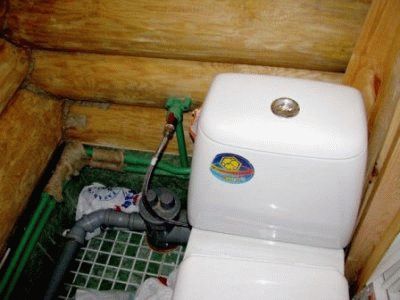
You can quickly solve the problem, of course, by purchasing. However, given that the volume of its receiving tank is only 10-12 liters, estimate how convenient it will be for those living in the country.
So, you finally decided to organize a real warm toilet in country house. We will do it in stages.
1. Room enclosure.
For a warm toilet in the country, it is better to single out not the central, but the corner part of the house, closer to the intended place of drainage. Thus, you will save on the footage of the pipes being laid. Separate toilet space from living rooms possible with the help wooden partitions, brickwork or oriented strand board.
2. Choice of cleaning system Wastewater.
We will not go deep into the theory of the issue. The most common way for summer residents - biological treatment. It is based on the vital activity of special bacteria placed in a septic tank or well.
The most commonly used anaerobic and aerobic wastewater treatment systems. They involve the use of a septic tank - a special container where the mentioned bacteria decompose human waste. Then the runoff enters the soil through the drainage or, if the soil does not absorb moisture well, to the filtration site - the nearest ditch.
The septic tank should not be closer than 5 meters from the house and 20 meters from the well or well. Its volume should be three to four times the daily water consumption in the country.
3. Design and elements of the system.
To make two containers will optimal solution. In the first one, the primary decomposition of wastewater will take place, in the second - the final one.
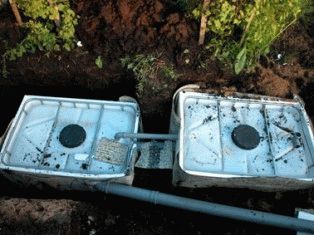 For a homemade cleaning system, you can use plastic containers, which are sold in warehouses of returnable packaging or at paint and varnish enterprises. In the first container, an entrance for the drain pipe is made, between the containers - a message and, further, an output ventilation pipe and drainage outlet.
For a homemade cleaning system, you can use plastic containers, which are sold in warehouses of returnable packaging or at paint and varnish enterprises. In the first container, an entrance for the drain pipe is made, between the containers - a message and, further, an output ventilation pipe and drainage outlet.
Pipes for a warm country toilet are suitable for ordinary sewer pipes with a diameter of 100-150 mm. It is most convenient to work with metal-plastic. Their sections are connected by collets and fittings; a tee with a connector is used for entry.
If a warm toilet is designed for use in winter, then the pipes should be laid to a depth of at least 1.5 meters and insulated.
A simpler organization of a biotreatment system is also possible - the installation of one large capacity or a well made of concrete rings. The bottom of the well is sealed with several layers of roofing material, waterproofing or cement. The joints of the rings are sealed with liquid glass or cement mortar. Top cover the well in which the inspection hatch is made is tightly fitted.
The output of the contents is organized in the area of the lower ring, or they simply call a car and pump out about 1-2 times per season. Such a warm toilet in the country is done quite often.
4. Water supply.
For the functioning of a warm toilet, you will need to make a constant supply of water. There are two options here: connect to the water supply available in the country house or using the station automatic water supply and water storage tanks to make an autonomous supply. The station, with the help of a pump and automation, will maintain the required water pressure in the line. This will allow you to do not only, but also a shower in a country house.
5. Installation and connection.
So everything preparatory work carried out, we proceed to connect the entire system. We fasten the toilet with screws to a wooden sleeve or directly to the floor perpendicular to the exhaust pipe. Next, we wrap the outlet with plumbing tape, insert it into the socket, sealing the annular gap. It remains to attach cistern and other communications.
We launch in plastic containers or a bioseptic well and a warm toilet in the country are ready. Like this DIY project sewer for country house. You can start using.
How to make an unusual, creative country toilet, you can see on the website "Azbuka dacha"


















